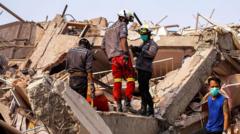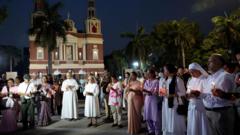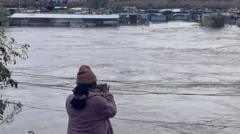The devastating impact of a powerful 7.7 magnitude earthquake that struck Myanmar on Friday has led to a tragic death toll of at least 1,700 people. Rescue efforts remain intense, with additional survivors being pulled from the rubble nearly 60 hours after the quake. As regions struggle to cope with the aftermath, international aid is beginning to flow into the crisis areas.
### Myanmar Earthquake: Ongoing Rescue Efforts Uncover More Survivors Amid Rising Death Toll

### Myanmar Earthquake: Ongoing Rescue Efforts Uncover More Survivors Amid Rising Death Toll
International aid teams converge on Myanmar and Thailand as search operations continue for earthquake survivors, with over 1,700 confirmed dead.
On Sunday, rescue operations in the Sagaing region yielded four more survivors from the wreckage of a collapsed school, according to Myanmar's fire service. A body was also discovered at the site, underscoring the grim reality of the ongoing crisis. The magnitude of the disaster has left hundreds still unaccounted for, as authorities in both Myanmar and neighboring Thailand labor to locate those missing.
While international assistance starts to arrive, many survivors were initially left to dig through the debris by hand due to delays in aid. Noteworthy rescues include an elderly woman in Nay Pyi Taw who was successfully extracted after spending 36 hours trapped under hospital rubble. In Mandalay, local officials revealed that 29 individuals were saved from another collapsed apartment building.
The earthquake struck near Mandalay around 12:50 PM local time (06:20 GMT) on Friday, causing significant tremors in neighboring countries as well. A subsequent quake with a magnitude of 6.4 occurred shortly after, prompting widespread aftershocks, including a recent 5.1-magnitude tremor recorded north-west of Mandalay.
The catastrophe has reverberated beyond Myanmar's borders, with a high-rise construction site in Bangkok collapsing, claiming the lives of at least 18 people. Rescuers are still searching for 76 workers missing from the site. Investigations point to potential construction flaws, with the local government pledging to support affected families.
As the situation evolves, various nations—including China, India, Malaysia, and South Korea—have dispatched rescue teams and supplies to assist in the disaster response. The UK also has pledged £10 million in aid to help those in dire need.
The civil unrest within Myanmar complicates the situation further. The ruling military junta has continued its airstrikes in parts of the country, leading the UN to label such actions as "completely outrageous and unacceptable." In the face of this turmoil, pro-democracy rebel groups have reported ongoing military operations, although the National Unity Government—representing the ousted civilian administration—has temporarily paused offensive operations in the earthquake-affected regions.
As the monsoon season approaches, concerns about further displacement and the deterioration of conditions for affected communities are rising. Organizations like the International Rescue Committee warn that previous flooding caused by monsoon rains could exacerbate the already critical situation.
With ongoing rescue efforts and international involvement, the focus remains on finding survivors and addressing the urgent humanitarian needs in Myanmar and Thailand.
While international assistance starts to arrive, many survivors were initially left to dig through the debris by hand due to delays in aid. Noteworthy rescues include an elderly woman in Nay Pyi Taw who was successfully extracted after spending 36 hours trapped under hospital rubble. In Mandalay, local officials revealed that 29 individuals were saved from another collapsed apartment building.
The earthquake struck near Mandalay around 12:50 PM local time (06:20 GMT) on Friday, causing significant tremors in neighboring countries as well. A subsequent quake with a magnitude of 6.4 occurred shortly after, prompting widespread aftershocks, including a recent 5.1-magnitude tremor recorded north-west of Mandalay.
The catastrophe has reverberated beyond Myanmar's borders, with a high-rise construction site in Bangkok collapsing, claiming the lives of at least 18 people. Rescuers are still searching for 76 workers missing from the site. Investigations point to potential construction flaws, with the local government pledging to support affected families.
As the situation evolves, various nations—including China, India, Malaysia, and South Korea—have dispatched rescue teams and supplies to assist in the disaster response. The UK also has pledged £10 million in aid to help those in dire need.
The civil unrest within Myanmar complicates the situation further. The ruling military junta has continued its airstrikes in parts of the country, leading the UN to label such actions as "completely outrageous and unacceptable." In the face of this turmoil, pro-democracy rebel groups have reported ongoing military operations, although the National Unity Government—representing the ousted civilian administration—has temporarily paused offensive operations in the earthquake-affected regions.
As the monsoon season approaches, concerns about further displacement and the deterioration of conditions for affected communities are rising. Organizations like the International Rescue Committee warn that previous flooding caused by monsoon rains could exacerbate the already critical situation.
With ongoing rescue efforts and international involvement, the focus remains on finding survivors and addressing the urgent humanitarian needs in Myanmar and Thailand.






















